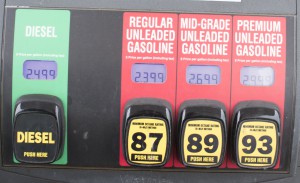
Gas prices moved upward – on average – for the first time in five weeks this week, according to AAA.
With the summer driving season in full swing AAA reports that gasoline prices across the U.S have begun to creep upward.
For the first time in five weeks, the national average gas price is rising. At $2.26, today’s price has been moving higher since July 6, and is three cents more than last week. The price increase follows a week of solid demand growth and a third straight week of gasoline inventory drawdowns across the country.
“Gas prices are still at some of the cheapest prices we’ve seen this year, but consumers should take advantage of them while they can,” said Jeanette Casselano, AAA spokesperson.
“This week, drivers in 31 states are paying more than last week for a gallon of gas. And we expect to see slight price increases throughout July, so now’s the time to hit the road.”
(Honda Accord tops most stolen vehicle list for 2016. Click Here to see the details.)
Of the states seeing jumps in gas prices, Indiana, Ohio, Michigan and Kentucky top the charts with double-digit increases. Thirteen states, mostly on the West Coast and in the Rockies, saw prices decrease by pennies. Across the country, consumers can find gas for $2.25 or less at 58% of gas stations.
Meanwhile the price of crude oil continues to drop on global markets, AAA observed.
Last week’s market losses continued into Monday morning, with West Texas Intermediate opening just below $44 per barrel. Last week’s EIA report showed encouraging trends for the market, revealing increased gasoline demand and a decrease in crude storage levels.
(Click Here to see how Republicans plan to supersede state laws about autonomous driving.)
For gasoline, the week ending on June 30 saw demand at 9.705 million barrels per day – representing an increase of 167,000 from the previous week. Crude oil storage levels were down by 6.3 million barrels. Typically, these figures would lead the market to believe that increasing gasoline demand is beginning to drain the glut of crude that has kept prices low for most of the year.
However, two new pieces of information have led the market to believe that the glut of crude oil may be replenishing at a faster rate than expected:
Baker Hughes Inc. reported that the U.S. added seven oil rigs last week. The total number of rigs stands at 763, diminishing belief that last week’s decrease in the number of rigs could have signaled a new trend of slowing production levels in the U.S.
(Mexico auto exports to U.S. reach record high in June. Click Here for the story.)
During the past two weeks crude oil output from Libya, a member of OPEC but exempt from OPEC’s agreed production cuts through March 2018.
